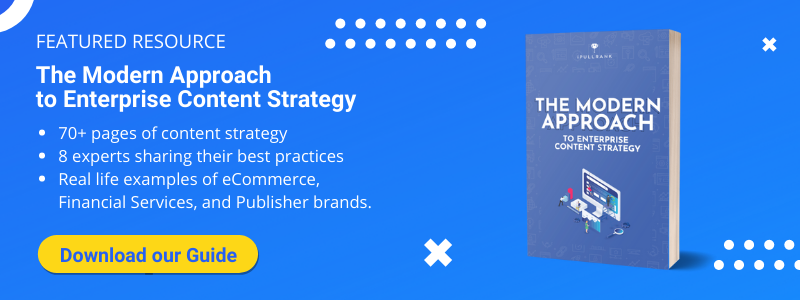Have you ever read content like this?
Want the best digital camera for your agency? Our digital cameras are the best money can buy whether you’re a seasoned pro or beginner. We offer digital camera brands like Canon and Nikon and all of the digital camera accessories you need.
This reads like gobbledygook.
And it is.
Seasoned SEOs will point out that it’s gross, keyword-stuffed content that won’t generate revenue, and they’re right! But it’s actually a sign of a much deeper problem.
Poor content engineering.
Wait, what?
What is content engineering?
Michael King, Founder and CEO of iPullRank, sat down with Jason Barnard, CEO of Kalicube, to discuss The Value of Content Engineering. He shares why this neglected practice is actually an essential part of content marketing success.
(Here’s the webinar if you’d like to watch)
Content engineering includes what most people call semantic search.
The whole idea with semantic search is that content is built around topic clusters rather than simply focusing on keywords. The change came with Google’s Hummingbird update.
Google stopped focusing on keywords.

With their latest update, they were now able to understand a page’s topic and intent; they could also identify which pages were best for users, producing more relevant and helpful content.

Google wants topical authority.
They want to see that you’re the go-to resource or subject matter expert for a particular subject area. Take Backblaze, for example.
According to their website, they sell “Scalable, low cost cloud backup and storage services.” Here’s the thing about Backblaze, they understand the value of topical authority.
They’ve used their data centers and expertise to create 10x, hard-to-copy content.
Here are a few highlights to show you what I mean.
- Q3 2021 Hard Drive Failure Rates
- Drive Failure Over Time: The Bathtub Curve is Leaking
- Using Machine Learning to Predict Hard Drive Failures
- Hard Disk Drive (HDD) vs. Solid-state Drive (SSD): What’s the Diff?
- Are SSDs Really More Reliable Than Hard Drives?
There’s a long list of content-oriented around hard drives on their site, hitting this one particular subject from deep authoritative angles.
And here’s the thing.
A quick scan of Google search results seems to indicate that they’re viewed as a topical authority.
They consistently perform well, outshining heavy hitters like Best Buy for competitive queries.
Why should you care?
Here’s a brief excerpt from Dave Davies, from his post at Search Engine Land.
“Working toward topical authority can provide a broader net of keywords, generating large volumes of quality content around a specific topic, provides an almost perfect scenario.
- When people are looking for places to reference/link to/socially share – you will be it.
- When users are looking for answers to their supplemental questions – they will remain at your site and not be forced off to find their answer elsewhere.
- When Google is looking for an answer to a question – you will have it.
- When Google is determining if you have additional information to meet other user intents – you’ll have that covered, too.”
This is powerful.
Yet, in 2021, we’re still seeing established brands create one-off content that’s heavily dependent on outdated strategies like keyword stuffing.
You’ve probably seen this.
A copywriter creates thematically relevant content but doesn’t include any of the brand’s target keywords. This is, of course, a non-starter; executives want to see performance moving up and to the right.
The copywriter receives a list of keywords.
They go back in and ‘sprinkle’ (stuff) the target keywords throughout the post. What started as a thoughtfully written post is now a hard-to-decipher mass of words.
This tactic doesn’t work anymore.
But semantic search already has a name? Why would we need to give it another one with something like content engineering?
Because semantic search is a small part of it.
With content engineering, you’re reverse-engineering the heuristics and details that Google wants to see. This means you’re approaching content development with a comprehensive point of view.
You’re asking key questions:
- Who is our audience? These are the people who consume your content. They’re completely separate from the people who purchase your products or services. Your audience typically consists of diverse people — customers, industry experts, competitors, detractors, casuals and tire kickers, and fans.
- What specifically do they want from us? The needs of your audience are diverse. More importantly, you’re going to need to determine which audience members you’ll cater to and which ones you’ll ignore (i.e., competitors). Some of your audience members are simply knowledge seekers looking for information; nothing wrong with that. Others are customers using the information you provide as a heuristic to gauge value and compatibility (e.g., quality, market positioning, price alignment). A select few may use you as leverage against a preferred service or competitor.
- Who are our customers? As you know, this question isn’t as simple as it sounds, but we’ll start this. You’re looking for people who are willing and able to pay for your products and services at your standard price point. This means you’ll need a multi-layer, ever-evolving understanding of your customer data (e.g., demographics, psychographics, ethnographics, cohorts, etc.).
- What specifically do they want from us? Are your customers looking for a low-priced product that’s good enough? A high-priced product that confers status, prestige, and bragging rights? High-quality utilities with little to no failure points? A product that hits the right notes emotionally, or a product that’s technically precise and beautifully engineered?
- What are the behavioral drivers of each group? This includes their desires, goals, fears, frustrations, problems, culture, values, and norms. This tells you how to approach both groups; this data shows you how these groups communicate with each other, how you should speak with them, and how to build strong relationships.
This, in turn, provides you with:
- The clarity your team needs to structure your wireframes, content experiments, and information architecture properly, maximizing conversions.
- This is an excellent starting point for your keyword research; your team will have a clear sense of the topics important to each cohort and the segmentation needed to harmonize your marketing messages. You’ll also have an easier time expanding your keyword research or finding new queries.
- Crucial data you need to optimize usability — optimizing your site (e.g., messaging, forms, navigation, call to action, etc.) around the people you want to use your site, frequent your business, follow your company, etc.
- The know-how needed to expand your digital footprint. You appear in more search results, and your content is placed in front of the right people more consistently — producing more traffic, leads, and sales.
- The coveted position of industry thought leader, as more and more of the industry sees you as the answer for anything and everything related to your topic or your company.
- Strong rankings, you’re creating the content your audience and your customers want to see; Google rewards you by consistently ranking your business for traffic that drives revenue.
- Priorities: You’re fully aware of the to-dos that need your attention and the to-dos you should always say no to. You’ll also get a clearer picture of the when (e.g., customer surveys every 12 weeks) involved with each of your to-dos.
- Clarity on triggering events: The data you’ve collected tells you which triggering events are important to your audience and your customers. Fewer accidents with faux pas, less crisis management spending, and more resources dedicated to serving both groups.
- Instructions, procedures, and systems you’ll need to ensure everyone who touches your campaign’s content follows the plan. If there are any issues or problems, there’s a clear chain of command and a process that’s followed.
This is what content engineering is all about.
Content engineering gives everyone on your team a clear, data-driven plan of action to follow. They’ll know who they’re speaking to and what they want.
They’ll also know the content that should be discussed and keywords, topics, phrases they should incorporate into their copy. They’ll have an intimate understanding of the tangential content that should be created to supplement and amplify the pieces they’re producing now.
This is content engineering.
But it only works if you have the systems in place.
The secret to a successful content engineering package
Your content engineering package includes the relevant data that we’ve discussed earlier. The aggregate data would be overwhelming for any one person. It’s a good idea to share information with the team on a need-to-know basis.
To do that, you’ll need four things:
- Content engineering package: This includes lots of campaign-specific data — topical clusters, keyword clusters and groups, the co-occurring terms, the entities searchers expect when they use these keywords, the series of pages needed to satisfy the needs of a particular cluster, and more. Your content engineering package treats Google as another persona or audience member you need to satisfy. This forces the team to align the campaign with three groups and their cohorts: (a.) audience members you’ve prioritized, (b.) customers, and (c.) Google (e.g., Google News, Maps, Search, etc.). The better you are at optimizing your campaigns around these three groups, the easier it is to drive traffic that generates revenue.
- Content engineering brief: These briefs provide those in your campaign with the specific information they need to complete their steps in the process. For example, your copywriter wouldn’t necessarily need to have access to the content clusters you’ve created, but they would definitely need information on the audience or cohort they’re writing for.
- Content plans: These are roadmaps that provide teams with a high-level view of the content trajectory for each campaign — the list of content we’ll need to create over the next year, the structure of that content, and how it all fits together. This also includes content strategy, how the content will be implemented, and how the plan will change over time.
- Information plans: This would lay out some of the more technical details of a project or campaign. For a new website, this may include the taxonomy, tagging structure, linking structures, information architecture, navigation structure, etc. An information plan guides technical teams, showing them how a site (and content) should be built, structured, and maintained, but, key point, it’s still data-driven and oriented around our key customer, audience, and search segments.
Why are these necessary?
These two engineering tools ensure that SEO won’t be added as an afterthought; it will begin as an integral part of the process and remain that way, from start to finish.
Why does that matter?
Our perspective is — there’s no such thing as “SEO content;” there’s simply content that performs or content that doesn’t.
What does this mean?
Many people create content for their paid channels; next, they create content to appease Google. Or Facebook and Twitter.
It’s costly and totally unnecessary.
How’s that?
With content engineering, you simply create content. You bring your personas and cohorts into the development process, and your team works to align the interests of each group — your customers, audience, Google, and yours.
According to Michael King, CEO of iPullRank, Google is another persona your content needs to align with.
“No one knows Google’s algorithms, but we can determine what they think is valuable by parsing out those pages using natural language processing and then looking at what these features are. Then we can create content that map to those features.
I’m not saying ‘Let’s do just like a really complex version of keyword stuffing,’ Rather it’s discussing how we actually talk about these same subjects, how we create something that makes and matches what a user wants.
It’s about aligning with Google, I always talk about marketing in terms of personas and I’ve always thought of Google as another one of those personas.”
It’s efficient and wildly profitable.
Here’s why.
Successful content becomes an omnichannel resource you can repeatedly deploy to drive traffic and revenue; it’s profitable because you know your audience well. But this only works if your team is properly briefed.
What you need to create is a content brief
Content briefs are essential.
They’re your team’s marching orders, providing them with the clarity and instruction they need to create content that performs well consistently. Successful content becomes the rule rather than the exception with the right brief and an efficient process in place.
The content brief is your opportunity to spell out the ingredients necessary for successful, ready-to-publish content. Great content briefs outline:
- Content goals (e.g., conversion, relationship, branding, etc.)
- The personas you’re targeting
- These are the keywords and keyword clusters that should be used
- The topics, ideas, and key points that need to be covered
- The questions that need to be answered
- Structured data and data sources that can or should be used
- Tone, voice, and style requirements (consistent with each persona)
- Requirements around media and assets (i.e., use these keywords with images)
- Schema markup (e.g., how-to, product, reviews, software, and FAQ) and annotations
- Brand guide and brand requirements
These briefs are instructions, but they also function as a checklist.
If the content that’s turned in doesn’t meet the requirements in the content brief, then that content is flagged for review and remains unpublished. According to King, the brief documents what you want, but it’s also used as a kind of performance checklist for the content you’re creating.
“If you’re working in the environment that we work in as an agency, we have to step back and say ‘Here’s the idea now, here’s how we want to execute that idea.’
In your brief you have the opportunity to say okay here are the personas we’re targeting, here are the keywords that we should use, here are the topics that we need to cover, here are the questions that we need to answer, here’s the structured data we want to use.
That way when you build this robust brief everyone that’s creating content knows that they need to account for these things. Ultimately if what’s turned in (whether it’s by the client or by us) doesn’t meet those expectations then we haven’t met the requirements in the brief and we don’t publish that piece of content.”
Isn’t that what everyone else is doing?
Not at all.
For many brands, the process goes like this:
They create a content brief.
Creators use that brief as a prompt to determine who the audience is and what they expect. If sales says, “Hey, we need you to create content that focuses on our new upcoming features,” creators do that. If managers demand that we discuss details customers don’t care about, these creators do that.
It’s a disaster.
Instead of being data-driven, content production becomes a game of tug of war, one that’s driven by the whims of the next department or manager who has an ‘urgent’ request.
Who gets left out in that scenario?
Your customers, your audience, and Google. This is the reason why so many content pieces fail to perform. These pieces are focused on the wrong people.
This is why content engineering is key.
Approaching content with an engineering mindset requires a data-driven approach; one that’s focused on research, facts, and performance data. It’s the quantitative leg work your team has done ahead of time. Once you’ve done that, you’ll need to decide who should create your 10x content.
It shouldn’t be SEOs.
In fact, your SEOs shouldn’t be writing content.
Your copywriters should be creating content. It’s common for SEOs to obsess, to get sucked into the trap of linear thinking — i.e., we need to focus on these keywords and clusters; this isn’t a great way to connect with your target audience, which is why we say.
You need a copywriter.
Many SEOs approach content metadata clinically; they include the required keywords and call it a day. A copywriter sees this precious space for what it is — an advertising headline.
They’ll write accordingly.
Sophisticated copywriters can blend the engineering and advertising, the left and right brain aspects of your copy, creating content that hits all of the right notes from your content brief. King feels SEOs shouldn’t be writing content!
“If we start writing as SEOs, then we all get into this very linear thinking around the keywords. I believe it’s better to have something from an actual writer and I’ve always been a big proponent of this — copywriters should be the ones creating the content, even metadata.
I’ve always believed that copywriters should be writing that; if you think about something like a meta description it’s not just about shoving the keyword in there lots of times. It’s about using that as a kind of advertising tagline for the page in Google’s search results. It’s something that’s always going to be better written by a copywriter than an SEO.”
This is key.
When your content is written this way, it appeals to each segment, giving each group the exact information they need to convert. The content is written in a way that drives traffic and generates revenue.
Content engineering isn’t the future. It’s here, now
Content engineering is more than semantic search.
It’s an A to Z emphasis on the three most important people in a brand’s life. Their audience, their customers, and Google. As it turns out, all three groups want the same thing.
They’re looking for subject matter experts.
They want to see that you’re the go-to resource for a particular subject area. With your audience and your customers, they want to know that you’re focused on the areas that interest them. Building topical authority is automatic with content engineering.
You’ll have the answers your segments are looking for.
With content engineering, you’ll have the data-driven approach you need to drive traffic and generate revenue quickly.

- The Cost of SEO Services in 2024 - January 4, 2024
- The 2024 SEO Guide To Successful Website Migration - April 4, 2023
- How Audience Research Shapes Financial Services Marketing - February 16, 2023











Leave a Comment